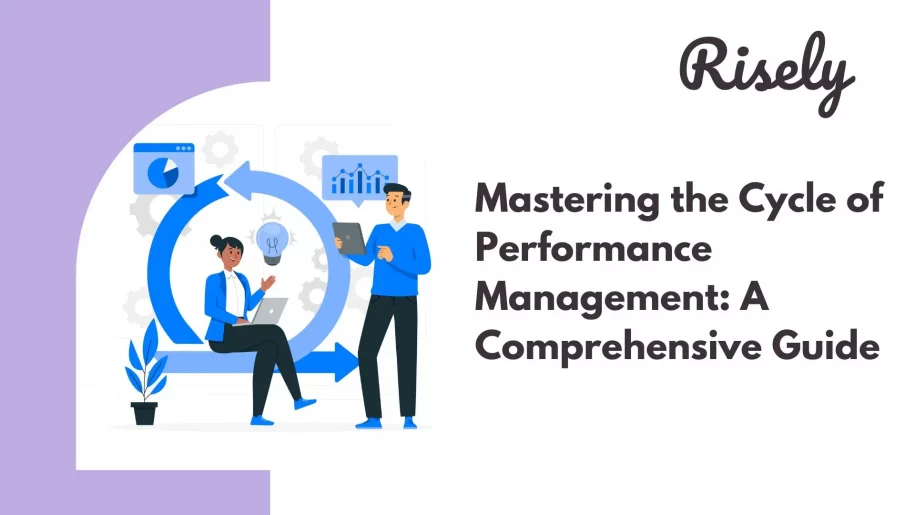Mastering the Cycle of Performance Management: A Comprehensive Guide
In the dynamic landscape of today’s workplaces, where every employee’s contribution matters more than ever, managing and optimizing performance has evolved. Gone are the days of annual, one-size-fits-all performance reviews that offer little more than a cursory glance at an employee’s achievements and shortcomings. Instead, we now find ourselves in an era where performance management is a continuous, interactive, and strategic process—a cycle that empowers employees, engages teams, and aligns individual efforts with the overarching goals of organizations. Keep reading as we discuss the cycle of performance management —a comprehensive guide to understanding each stage, from setting goals and offering feedback to recognizing achievements and driving continuous improvement. Discover how organizations and individuals can leverage this transformative process to unlock their full potential and thrive in the ever-evolving world of work.What is the performance management cycle?
The performance management cycle is a continuous and systematic process organizations use to manage and enhance the performance of their employees. It involves stages and activities designed to set expectations, monitor progress, provide feedback, and improve performance over time. This cycle of performance management helps align individual and team performance with organizational goals, fosters professional development, and ensures accountability.Why is the cycle of performance management important?
The cycle of performance management is crucial for several reasons, as it serves both organizational and employee development goals:- Enhanced productivity and efficiency: Through regular monitoring and feedback, performance management can improve employee productivity and efficiency. It enables employees to focus on high-priority tasks and make necessary adjustments to meet performance expectations.
- Employee development: Performance management provides a structured framework for employee development. Setting clear goals and expectations helps employees identify areas for improvement and growth, fostering their professional development.
- Feedback and recognition: The cycle includes regular feedback, essential for employee motivation and morale. Positive feedback and recognition for achievements can boost employee engagement and job satisfaction.
- Identification of skill gaps: Through performance evaluations, managers can identify skill gaps and training needs within the workforce. This information is valuable for planning training and development programs.
- Informed decision-making: Performance management data can inform HR decisions, such as promotions, transfers, salary adjustments, and succession planning. It helps in identifying high-performing employees and addressing underperformance.
Benefits of the cycle of performance management
The benefits of the performance management cycle for organizations and employees are substantial:For organizations
- Goal alignment: The performance management cycle helps align individual employee goals and objectives with the organization’s strategic goals, ensuring everyone works toward common objectives.
- Increased productivity: Regular performance monitoring and feedback can enhance employee productivity and efficiency, resulting in higher output and performance.
- Improved employee engagement: Engaging in performance discussions and recognizing achievements can boost employee morale and job satisfaction, leading to higher levels of engagement.
- Legal and compliance: Properly documented performance management processes can help organizations comply with legal and regulatory requirements, reducing the risk of legal disputes.
For employees
- Professional development: The cycle offers employees opportunities for professional growth by setting clear goals and providing feedback for improvement.
- Feedback and recognition: Regular feedback and recognition motivate employees, boost morale, and provide a sense of achievement.
- Skill enhancement: Employees can identify areas for skill development through performance evaluations, enabling them to take steps to improve their skills.
- Enhanced job satisfaction: Knowing that their contributions are recognized, and they have development opportunities can increase overall job satisfaction.
Other Interesting Reads
Stages cycle of performance management
1. Planning stage: The planning stage is the foundational step in the performance management cycle. Here, organizations establish the framework for assessing and improving employee performance. Key activities include defining clear job descriptions, setting performance goals, and establishing performance standards and expectations. Goal setting is a critical component, as it provides employees with a clear understanding of their objectives and how they contribute to the organization’s mission. During this stage, managers and employees collaborate to align individual goals with the broader organizational objectives. Effective planning ensures everyone is on the same page regarding what is expected regarding performance. Example: Defining key performance indicators (KPIs) that will be used to evaluate performance, such as the number of closed deals, customer satisfaction scores, or project completion times. 2. Monitoring stage: Once the planning stage is complete, the focus shifts to monitoring employee performance. In this phase, managers and supervisors regularly observe and evaluate employees’ progress toward their goals. Regular check-ins and feedback sessions are essential elements of this stage. Monitoring may involve assessing key performance indicators (KPIs), project timelines, or other relevant metrics. The aim is to ensure that employees are on track, identify potential issues or roadblocks early on, and provide support as needed. Effective monitoring promotes transparency, accountability, and the opportunity for timely course correction. Example: Managers hold regular one-on-one meetings with employees to discuss progress, provide support, and address challenges. 3. Developing and reviewing stage: The developing and reviewing stage is where the performance evaluation process takes center stage. Formal performance reviews or appraisals assess employees’ performance over a specific period. During these reviews, managers provide comprehensive feedback, highlighting strengths and areas needing improvement. The employee’s performance against established goals and standards is thoroughly discussed. This stage also serves as a platform for setting new performance objectives and creating development plans to enhance skills and capabilities. Regular and constructive feedback is essential for employee growth and improvement. Example: Using rating scales or performance appraisal forms to assess performance against established criteria. 4. Rating and rewards stage: The rating and rewards stage involves assessing employee performance and determining appropriate recognition and rewards. Performance ratings may be assigned based on the results of performance appraisals. Managers consider achievements, progress toward goals, and adherence to performance standards. Recognition and rewards, including salary increases, bonuses, promotions, and other incentives, are used to acknowledge and motivate high-performing employees. This stage is crucial for reinforcing positive behaviors, promoting job satisfaction, and retaining top talent. Examples: Managers awarding monetary rewards or bonuses for exceeding performance targets. In conclusion, the performance management cycle comprises four key stages, each serving a specific purpose in setting, monitoring, and evaluating employee performance. Effective planning lays the groundwork, monitoring ensures employees stay on course, development and reviewing fosters growth, and rating and rewards recognize and incentivize outstanding performance. A well-executed performance management cycle contributes to organizational success by aligning individual efforts with strategic objectives and promoting continuous improvement among employees.Best practices for the cycle of performance management
Best practices for the cycle of performance management encompass a range of strategies and approaches aimed at optimizing the process and ensuring it delivers maximum value to both employees and the organization. Some key best practices:- Continuous feedback: Move away from an annual performance review model and embrace ongoing feedback. Regular, informal discussions about performance help employees stay on track and make necessary real-time adjustments.
- Training and development: Invest in employee development. Offer training, coaching, and resources to help employees acquire new skills and improve their performance. Development plans should be tailored to individual needs.
- Fair and objective evaluation: Ensure that performance evaluations are fair, objective, and based on concrete evidence. Use standardized rating scales and provide specific examples to support assessments.
- Performance improvement plans (PIPs): When employees struggle to meet performance expectations, use performance improvement plans (PIPs) to create a structured roadmap for improvement. Collaborate with the employee to set achievable goals and provide the necessary support.
- Document everything: Record performance-related discussions, feedback, and evaluations thoroughly. This documentation can serve as a reference for future evaluations and, if necessary, for addressing performance-related issues.
Conclusion
As we reach the end of our blog through the intricate landscape of the cycle of performance management, it becomes evident that this process is not merely a bureaucratic requirement but a dynamic force for positive change within organizations. The cycle of performance management represents a shift towards a more holistic and continuous approach to nurturing employee growth and organizational success. It’s a journey that begins with establishing clear goals, fosters a culture of open communication, and celebrates achievements, all while addressing areas for improvement. For organizations, embracing the performance management cycle means unlocking the full potential of their workforce. It’s about aligning individual aspirations and contributions with overarching business objectives, ultimately driving innovation, productivity, and success.Ready to Elevate Your Management Skills?
Take free assessment on constructive feedback and enhance your performance management cycle today!
Other Related Blogs
5 Unique Benefits Of Online Leadership Coaching
5 Unique Benefits Of Online Leadership Coaching Remember the days of leadership development being confined to a stuffy conference room filled with flipcharts and generic advice? Yeah, those days are…
Performance Management Training: Empowering Managers To Manage Better
Performance Management Training: Empowering Managers To Manage Better Remember that feeling of dread when you knew performance review season was rolling around? Yeah, us, too. For many employees, performance reviews…
Manager Development Goals And How To Reach Them: Opportunities And Areas To Focus On
Manager Development Goals And How To Reach Them: Opportunities And Areas To Focus On You’ve meticulously crafted a development program for your high-potential employees, but their managers just aren’t on…
Grooming for Management: The Key to Building a Sustainable Leadership Pipeline
Grooming for Management: The Key to Building a Sustainable Leadership Pipeline Imagine a crucial leadership position opening up in your organization. You scramble to fill the role, internally and externally,…


